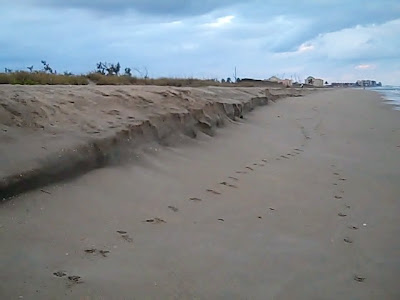 Side Scan Sonar Image of Wreck in 200 Feet of Water.
Side Scan Sonar Image of Wreck in 200 Feet of Water.That is one sharp image of a ship off Key West obtained by
The Dare on a test run while preparing to head up north to find the “Lost Merchant.”
The image and information was obtained via email from the Fisher organization.
Someone asked me the other day how to properly hunt a beach. That is an interesting question. Unfortunately a good answer to that question would be long and perhaps surprisingly complex.
Let me begin to address the question even though I'm sure I can't do the question justice in a single post and probably not in a hundred posts. I'm not sure I can do the question justice at all, but I'll give it a shot and maybe something of value will come of it.
Before I begin, let me say that I'm really not suggesting that I have the "right" answer, and I want you to know that the following is nothing more than my opinion. Maybe it will help someone, if only to convince them that I don't know what I'm talking about.
First there is no single way to properly hunt a beach. There are different strategies and techniques, and some can be applied to one situation while others might better be applied to other situations.
Some of the most important factors to consider are what you want to find, where you are hunting, and the local beach conditions. Much of the intent of this blog is to provide information on beach conditions.
Before really getting into the meat of the subject, I need to provide some background.
Success can not be guaranteed on any one outing, but you can over the long haul learn to succeed more frequently. It is about probabilities and doing what ever you can to improve the probability of success on any given outing.
There is way too much beach for anyone to cover completely. Therefore, it becomes a matter of spending your time in the right places. Some places are much more productive than others.
First you have to define your own idea of success. Some people want to find things with the highest economic value, other people want to find old things, other people want to find things of historic interest, and other people are perfectly content to go out, get some exercise and fresh air and pick up a few coins.
Your goals should match your personality, goals and circumstances. Most people would like to find something like the treasure of the Atocha, but most people do not have either the optimism, patience, and abilities and resources or commitment to do something like that. High value targets like that usually require tons of perseverance and commitment, and many people would give up way before finishing the task.
Besides personality, situation plays a role. If you want to pan or mine for gold and live in Fort Pierce, your situation doesn't match your goals very well.
Where you live has a lot to do with what you should target, unless you are willing to travel or move.
If you live in South Florida, you should be able to learn to do well hunting modern jewelry. If you live on the Treasure Coast, hunting modern jewelry is not as economically productive as in South Florida.
The Treasure Coast has the famed shipwrecks but hunting shipwreck coins and artifacts isn't easy. Unless you dive and work with someone that has a lease,you are pretty much confined to hunting the beaches, and most of the time the conditions are not good for that.
My main point of all of that is that you have to have some clarity about your own personality, your situation, what you are willing to invest in time, effort, and expense, and your goals before you can maximize the probability of success however you define it.
If you don't have too much patience and easily get discouraged or give up, set goals that are realistic and more easily achievable. Expand the number of things that you target. And learn to enjoy the hunt.
Given all of that, once you decide what you want to find then you can begin to learn the best ways of being successful in finding that particular kind of thing. There are different things to find, and many of them require different strategies an techniques.
One of the things you can do to improve your success rate is to be adaptable. Learn to hunt a variety of different types of things. That requires more knowledge and a variety of different strategies and techniques.
Learn to identify the conditions that are best for different types of hunting and adapt to the current conditions. Take what the beach is offering.
I'll pick up on that in future posts.
Forecast and Conditions.Not much has changed since yesterday as far as I can see. The beach looks the same. The wind is still coming from the north. There are some spots where you can find bunches of modern coins.
Friday looks encouraging. The seas will be increasing to around 6.5 feet Friday morning. That should improve the spots where there is already some erosion, and there are already a few of those.
Happy hunting,
TreasureGuide@comcast.net
 First Treasure Coast Sun Rise of 2011.
First Treasure Coast Sun Rise of 2011. First Cut I Hunted in 2011.
First Cut I Hunted in 2011. First Artifact I Found With Metal Detector in 2011.
First Artifact I Found With Metal Detector in 2011.






























